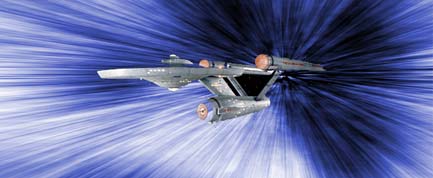Reality Check: The Science of 'Star Trek'

When "Star Trek" first promised to boldly go where no man had gone before, it spun tales involving a dazzling array of futuristic technologies such as phasers and cloaking devices. How many of those devices are now actually realities today, and how many remain in the distant future?
Phasers
When it comes to ray guns, a number of directed energy weapons that can either stun or kill like "Star Trek" phasers have been announced in recent years. These have included microwave blasters that make people feel as if their skin is on fire and plane-mounted lasers to knock out missiles, explained Lawrence Krauss, a theoretical physicist at Arizona State University in Tempe and author of "The Physics of Star Trek."
Transporters
As fantastic as teleportation seems, an extraordinary amount of research has led to great strides in the field over the past decade or so. However, when scientists talk about teleportation, they don't typically mean teleporting matter from one place to another. Rather, teleportation involves capturing the essential information about something — its "quantum state" — to recreate it exactly someplace else.
When it comes to quantum teleportation of a person, there are many, many caveats involved. To start, measuring the quantum state of an object essentially destroys it. Next, the average person is made of more than 10^27 atoms — a 1 with 27 zeroes behind it — and each atom is made of subatomic particles such as protons, neutrons and electrons, so measuring the quantum states of all of a person's particles would likely take a long, long time. Moreover, "quantum teleportation requires very carefully prepared quantum states, and that is something we as people are not and never will be," Krauss said.
Also, teleportation in "Star Trek" is receiverless — depicted as if you can just beam down from a starship to a planet without a receiver to collect the signal carrying you. Quantum teleportation requires a receiver at the other end.
Sign up for the Live Science daily newsletter now
Get the world’s most fascinating discoveries delivered straight to your inbox.
Cloaking devices
The cloaking devices used to render Romulan warships invisible may seem fantastic, but in the last decade a surprising amount of progress has been made into materials that can bend light around them, making them effectively invisible. "Unfortunately, this advance in cloaking only works for certain wavelengths of light, not every wavelength, so you can't be totally invisible," Krauss said.
Photon torpedoes
In "Star Trek," photon torpedoes are loaded with antimatter, which annihilates normal matter on contact. In the past 15 years, scientists have succeeded in creating whole atoms of antimatter. Still, "it would take many, many times the entire gross national product of the U.S. to create enough antimatter to light up a light bulb," Krauss said. "I wouldn't hold my breath."
Universal Translators
On Google, links displayed next to search results offer users automatic translations of Web pages in foreign languages. However, these translations are often less than perfect. "You can get a reasonable although rather amusing translation," Krauss quipped. "If on 'Star Trek' you tried to have such translation verbalized rather than typewritten, the end result could have been some interesting diplomatic snafus."
Communicators
Mobile phones are now found everywhere. According to a United Nations report released in March, 60 percent of the world's population uses them. "One thing I don't think we expected was how the communicator and the tricorder are kind of blending together — think of cameras and other sensors on phones like the iPhone," Krauss said.
Deflector shields
When it comes to deflecting weapons, "unfortunately, what 'Star Trek' never got right was how it's easier to build offensive weapons than defenses," Krauss said. "For instance, we're no closer to missile defense than we were before."
Tractor Beams
Scientists can use beams to pull and push matter — albeit on a microscopic level. Optical tweezers fire lasers at objects and impart force onto them without destroying them. The development of the idea helped win current Secretary of Energy Steven Chu and two other physicists the Nobel Prize in 1997.
"When it comes to moving larger objects, there haven't been any huge developments there," Krauss said. He did note the largest artificial magnets on Earth at the Large Hadron Collider "are amazing — they weigh something like 25,000 tons apiece, and apparently if turned on they could slam together from 30 feet apart, so as a stretch, you could say something like those could serve in a magnetic tractor beam."
Hyposprays
Devices that inject medicines into the body without needles were actually first patented in 1960, six years before the original "Star Trek" series first aired. As to why these haven't replaced syringes, "if it ain't broke, don't fix it," Krauss said.
{{ video="Time_travel_lite" title="Can You Time-Travel?" caption="The joys, terrors and true possibilities of navigating the Fourth Dimension. Credit: Imaginova" }} {{ video="Time_travel_deep" title="How To Time-Travel" caption="But how can you swim upstream in the river of time?" }}










